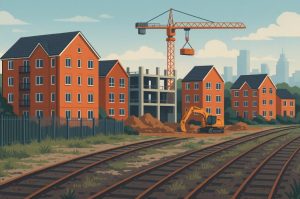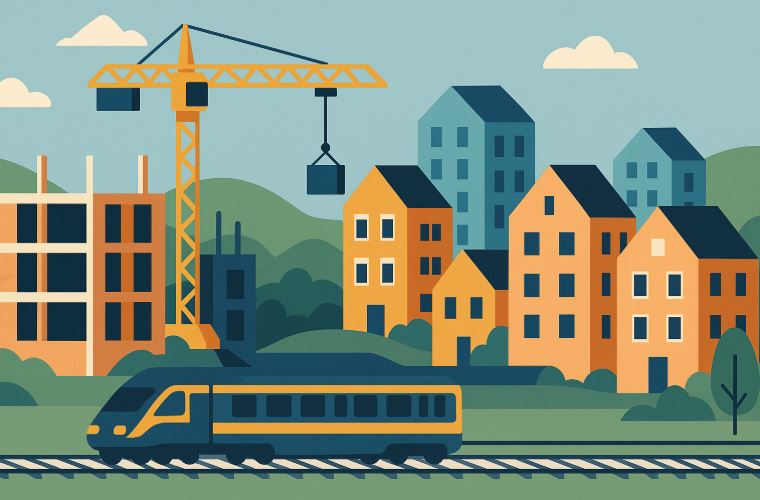Imagine walking through a once-forgotten railway yard, now alive with families, green parks, and thriving small businesses. This vision is no longer just an idealistic hope but a tangible reality being shaped by a groundbreaking government initiative.
As the UK continues to wrestle with a housing crisis that has locked generations out of homeownership, a bold new plan aims to unlock 40,000 new homes by revitalising surplus railway land across the country.
Launched in July 2025, this £1 billion development plan, spearheaded by the Department for Transport, the Ministry of Housing, and key ministers like Heidi Alexander and Angela Rayner, seeks to reshape urban Britain.
Let’s explore this strategic initiative that not only addresses the housing shortage but also champions regeneration, economic opportunity, and a new vision for urban development.
Why Is the Government Developing Homes on Brownfield Railway Land?

The UK’s persistent housing crisis has necessitated bold, innovative solutions. With urban sprawl reaching unsustainable limits and greenfield land becoming increasingly controversial to develop, brownfield sites, particularly disused railway land, present an attractive alternative.
Addressing the Housing Shortage
Thousands of first-time buyers and renters find themselves priced out of the property market. For many, the dream of owning a home remains out of reach. Meanwhile, under-utilised railway yards and surplus land sit idle, often in prime city locations.
The Brownfield-First Approach
The government’s new strategy puts brownfield land at the forefront of development. This land, already affected by industrial or transportation use, reduces pressure on the countryside and brings housing closer to transport links and existing infrastructure.
Why Railway Land?
Railway land is uniquely positioned to support sustainable growth. It is typically:
- Centrally located within urban centres
- Well-connected by existing public transport
- Surrounded by potential for retail, green spaces, and mixed-use development
This plan supports the Plan for Change, which aims to build 1.5 million homes and drive forward sustainable growth and regeneration.
Who Will Benefit Most from These New Homes?
The core focus of this initiative is inclusivity and accessibility. The government has made it clear that first-time buyers will be the principal beneficiaries. But they’re not alone.
First-Time Buyers
For young adults and new families looking to get a foot on the property ladder, these developments offer an affordable and realistic pathway. With the plan focused on providing quality homes, many will benefit from government-backed support schemes.
Working Families and Renters
The developments are designed not only for ownership but also for rental opportunities. In collaboration with developers like Grainger plc, affordable rental properties will be delivered within walkable communities.
Local Communities
Beyond housing, the developments will bring schools, shops, parks, and job opportunities. This means that existing local populations will also benefit from improved infrastructure and public spaces.
What Is Platform4 and Why Was It Created?

Platform4 is a newly formed government-owned development company, unveiled as the central body responsible for delivering the ambitious plan of building up to 40,000 homes over a decade on surplus railway land.
A Strategic Merger
Previously, two separate bodies managed this land: London and Continental Railways Ltd (LCR) and Network Rail’s Property Team. This fragmented structure often led to inefficiencies and missed opportunities.
By merging these entities into a single company, Platform4 consolidates resources, expertise, and strategic direction.
Leadership and Mission
The company is chaired by Bek Seeley, an experienced leader in transport-led regeneration. With a background in major developments across Europe, including as Chair of the Euston housing delivery group, she brings credibility and leadership to this massive undertaking.
The Company’s Objectives
- Deliver up to 40,000 new homes
- Unlock £1 billion in development
- Generate £227 million through more efficient delivery
- Create thousands of jobs
- Reinvest profits into Britain’s railway network
How Will Platform4 Deliver 40,000 Homes Over the Next Decade?
The roadmap for Platform4’s housing delivery is clear and structured. The target is ambitious, but the mechanisms are in place.
Development Timeline
The plan outlines a ten-year schedule with a target of delivering over 15,000 homes in the first five years. Platform4 will lead site identification, planning, developer partnerships, and land preparation.
Financial Overview
| Timeline | Number of Homes | Investment Target |
| First 5 Years | 15,000+ | £500 million+ |
| Full Decade | 40,000 | £1 billion+ |
Strategic Priorities
- Attract private sector investment of over £350 million
- Partner with local authorities and developers
- Ensure developments align with sustainability goals
- Integrate mixed-use designs including green spaces and retail
What Cities Will Be Transformed First by This Initiative?

The programme is already underway in several key UK cities, each chosen for its redevelopment potential and connectivity.
Overview of Priority Sites
| City | Project Name | Planned Homes | Key Features |
| Newcastle | Forth Goods Yard | 600+ | Unlocking new housing opportunities |
| Manchester | Mayfield Regeneration | 1,500 | Major urban renewal including jobs and green space |
| Cambridge | Mixed-use Development | 425 | Housing, commercial space and infrastructure |
| Nottingham | The Barnum Extension | 200 (+348) | Follow-up to previous successful housing delivery |
Manchester’s Mayfield Regeneration
One of the most ambitious projects, the Manchester Mayfield site, will deliver 1,500 new homes along with commercial space and parks. The area is expected to create thousands of jobs and become a hub for future growth.
Newcastle’s Forth Goods Yard
This site offers room for 600 homes, focusing on creating modern housing with excellent transport access and nearby community facilities.
What Impact Will the Housing Plan Have on the UK Economy?
This isn’t just a housing initiative. It’s a national regeneration project designed to catalyse economic development.
Job Creation and Local Investment
As these projects progress, thousands of construction, planning, architectural, and administrative roles will be generated.
Boosting the Private Sector
Private developers like Keepmoat, Grainger plc, and others will help accelerate delivery, supporting sustainable economic partnerships.
Economic Growth Forecast
| Economic Impact Area | Estimated Growth |
| Jobs Created | 10,000+ |
| Private Investment | £350 million+ |
| Land Value Released | £227 million |
| Local Infrastructure Spend | £100 million+ |
What Role Will Local Authorities and Private Developers Play?

Collaboration is at the heart of this initiative. While Platform4 leads the charge, local authorities and private developers are vital to on-ground success.
Key Public-Private Partnerships
- Keepmoat Homes will work in areas like Newcastle
- Grainger plc will develop rental-focused housing
- Home Builders Federation supports the scale of delivery
Local Government Involvement
Local councils will assist in zoning, approvals, and planning processes. Their participation ensures that developments align with community needs.
What Is the Significance of Surplus Railway Land in Urban Growth?
Historically overlooked, surplus railway land now plays a crucial role in reshaping British cities.
Why This Land Matters?
- Often in strategic, high-value urban locations
- Under-utilised but already equipped with infrastructure
- Provides opportunity for high-density, transit-friendly communities
A New Model for Urban Living
By turning former rail goods yards and industrial sites into residential areas, cities can expand inward rather than outward. This preserves countryside while revitalising inner-city areas.
What Is the Government’s ‘Plan for Change’?

The broader vision under which this housing plan falls is the Plan for Change, a government pledge to build 1.5 million homes across the UK by the 2030s.
Objectives of the Plan for Change
- Deliver housing where it’s most needed
- Prioritise brownfield land development
- Encourage mixed-use and transit-oriented neighbourhoods
- Drive up homeownership and affordability
The railway land initiative aligns perfectly with this strategy, offering a scalable and replicable model for the rest of the country.
Will Profits Be Reinvested into the Rail Network?
Yes, one of the most compelling features of this plan is the profit reinvestment strategy.
Funding Better Rail Services
Revenue generated through the sale and development of railway land will be reinvested into the UK’s railway system. This includes:
- Upgrading train stations and platforms
- Improving transport infrastructure
- Enhancing passenger experiences
This approach ensures taxpayers receive direct value, both in improved services and community benefits.
Conclusion
The government’s plan to build 40,000 homes on railway land is more than a construction project. It’s a comprehensive vision for housing, regeneration, economic growth, and urban innovation.
Through the creation of Platform4, strategic investment, and private partnerships, the initiative aims to solve long-standing challenges with a bold, future-focused approach.
By transforming disused railway land into vibrant neighbourhoods, the UK is setting a precedent for how infrastructure, housing, and sustainability can come together.
With first-time buyers, renters, and entire communities set to benefit, the future of urban development looks more connected and inclusive than ever.
FAQs
How will the homes on railway land be priced for first-time buyers?
The homes are intended to be affordable and accessible, particularly for first-time buyers. Pricing structures will vary by location, but aim to support people getting onto the property ladder.
Is Platform4 a private or public entity?
Platform4 is a government-owned property company formed by merging London and Continental Railways Ltd with Network Rail’s property development team.
Will there be green spaces in these developments?
Yes, developments will include parks, open areas, and sustainable landscaping to support community wellbeing and environmental standards.
What type of jobs will the initiative create?
The plan will generate construction, planning, design, and administrative roles, along with retail and service jobs in the new neighbourhoods.
What kind of developments will be built besides homes?
Besides residential buildings, the plan includes shops, hotels, office spaces, and community facilities to ensure holistic development.
How is the government ensuring sustainability in this project?
The use of brownfield land reduces the environmental footprint. Sustainable building practices and integrated transport access also support eco-friendly development.
Can other regions expect similar housing plans in the future?
Yes, if Platform4 proves successful, similar models may be replicated across other regions using unused public assets for community regeneration.









